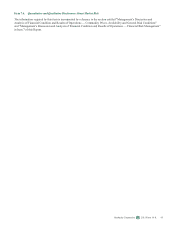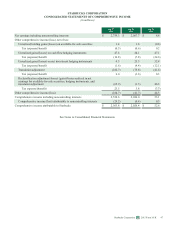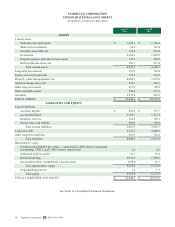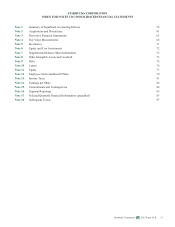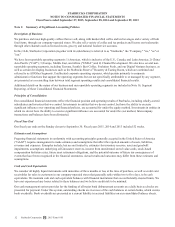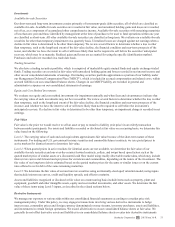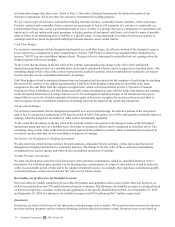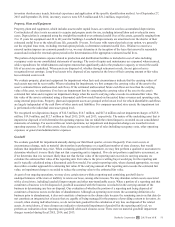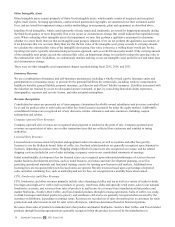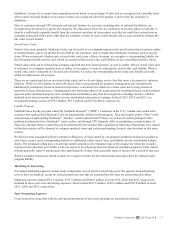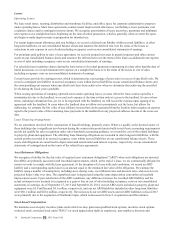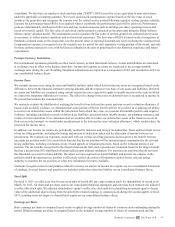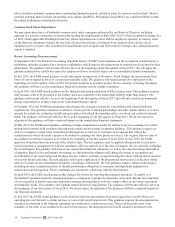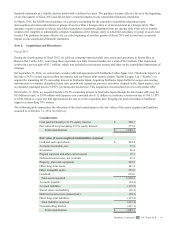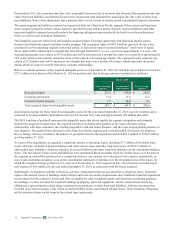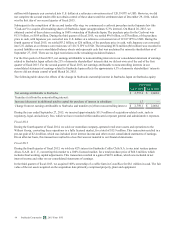Starbucks 2015 Annual Report Download - page 59
Download and view the complete annual report
Please find page 59 of the 2015 Starbucks annual report below. You can navigate through the pages in the report by either clicking on the pages listed below, or by using the keyword search tool below to find specific information within the annual report.
inventory obsolescence trends, historical experience and application of the specific identification method. As of September 27,
2015 and September 28, 2014, inventory reserves were $33.8 million and $31.2 million, respectively.
Property, Plant and Equipment
Property, plant and equipment, which includes assets under capital leases, are carried at cost less accumulated depreciation.
Cost includes all direct costs necessary to acquire and prepare assets for use, including internal labor and overhead in some
cases. Depreciation is computed using the straight-line method over estimated useful lives of the assets, generally ranging from
2 to 15 years for equipment and 30 to 40 years for buildings. Leasehold improvements are amortized over the shorter of their
estimated useful lives or the related lease life, generally 10 years. For leases with renewal periods at our option, we generally
use the original lease term, excluding renewal option periods, to determine estimated useful lives. If failure to exercise a
renewal option imposes an economic penalty to us, we may determine at the inception of the lease that renewal is reasonably
assured and include the renewal option period in the determination of the appropriate estimated useful lives.
The portion of depreciation expense related to production and distribution facilities is included in cost of sales including
occupancy costs on our consolidated statements of earnings. The costs of repairs and maintenance are expensed when incurred,
while expenditures for refurbishments and improvements that significantly add to the productive capacity or extend the useful
life of an asset are capitalized. When assets are disposed of, whether through retirement or sale, the net gain or loss is
recognized in net earnings. Long-lived assets to be disposed of are reported at the lower of their carrying amount or fair value
less estimated costs to sell.
We evaluate property, plant and equipment for impairment when facts and circumstances indicate that the carrying values of
such assets may not be recoverable. When evaluating for impairment, we first compare the carrying value of the asset to the
asset’s estimated future undiscounted cash flows. If the estimated undiscounted future cash flows are less than the carrying
value of the asset, we determine if we have an impairment loss by comparing the carrying value of the asset to the asset's
estimated fair value and recognize an impairment charge when the asset’s carrying value exceeds its estimated fair value. The
fair value of the asset is estimated using a discounted cash flow model based on forecasted future revenues and operating costs,
using internal projections. Property, plant and equipment assets are grouped at the lowest level for which identifiable cash flows
are largely independent of the cash flows of other assets and liabilities. For company-operated store assets, the impairment test
is performed at the individual store asset group level.
We recognized net disposition charges of $12.5 million, $14.7 million, and $17.4 million and net impairment charges of $25.8
million, $19.0 million, and $12.7 million in fiscal 2015, 2014, and 2013, respectively. The nature of the underlying asset that is
impaired or disposed of will determine the operating expense line on which the related impact is recorded on our consolidated
statements of earnings. For assets within our retail operations, net impairment and disposition charges are recorded in store
operating expenses. For all other assets, these charges are recorded in cost of sales including occupancy costs, other operating
expenses, or general and administrative expenses.
Goodwill
We evaluate goodwill for impairment annually during our third fiscal quarter, or more frequently if an event occurs or
circumstances change, such as material deterioration in performance or a significant number of store closures, that would
indicate that impairment may exist. When evaluating goodwill for impairment, we may first perform a qualitative assessment to
determine whether it is more likely than not that a reporting unit is impaired. If we do not perform a qualitative assessment, or
if we determine that it is not more likely than not that the fair value of the reporting unit exceeds its carrying amount, we
calculate the estimated fair value of the reporting unit. Fair value is the price a willing buyer would pay for the reporting unit
and is typically calculated using a discounted cash flow model. For certain reporting units, where deemed appropriate, we may
also utilize a market approach for estimating fair value. If the carrying amount of the reporting unit exceeds the estimated fair
value, an impairment charge is recorded to reduce the carrying value to the estimated fair value.
As part of our ongoing operations, we may close certain stores within a reporting unit containing goodwill due to
underperformance of the store or inability to renew our lease, among other reasons. We may abandon certain assets associated
with a closed store, including leasehold improvements and other non-transferable assets. When a portion of a reporting unit that
constitutes a business is to be disposed of, goodwill associated with the business is included in the carrying amount of the
business in determining any loss on disposal. Our evaluation of whether the portion of a reporting unit being disposed of
constitutes a business occurs on the date of abandonment. Although an operating store meets the accounting definition of a
business prior to abandonment, it does not constitute a business on the closure date because the remaining assets on that date do
not constitute an integrated set of assets that are capable of being managed for the purpose of providing a return to investors. As
a result, when closing individual stores, we do not include goodwill in the calculation of any loss on disposal of the related
assets. As noted above, if store closures are indicative of potential impairment of goodwill at the reporting unit level, we
perform an evaluation of our reporting unit goodwill when such closures occur. There were no material goodwill impairment
charges recorded during fiscal 2015, 2014, and 2013.
Starbucks Corporation 2015 Form 10-K 55


